

Compact Muon Solenoid
LHC, CERN
| CMS-PAS-FTR-21-007 | ||
| Projection of the Higgs boson mass and on-shell width measurements in H $\to$ ZZ* $\to 4\ell$ decay channel at the HL-LHC | ||
| CMS Collaboration | ||
| March 2022 | ||
| Abstract: The CMS High-Luminosity LHC projection of the Higgs boson mass and on-shell width measurement in the H $\to$ ZZ* $\to 4\ell$ ($\ell=$ e, $\mu$) decay channel is presented, processing a foreseen integrated luminosity of 3000 fb$^{-1}$. Several improvements, including a new approach to build the final likelihood, are implemented. The impact of the detector Phase-2 upgrades are studied considering different alternative systematic uncertanties scenarios. | ||
| Links: CDS record (PDF) ; CADI line (restricted) ; | ||
| Figures | |
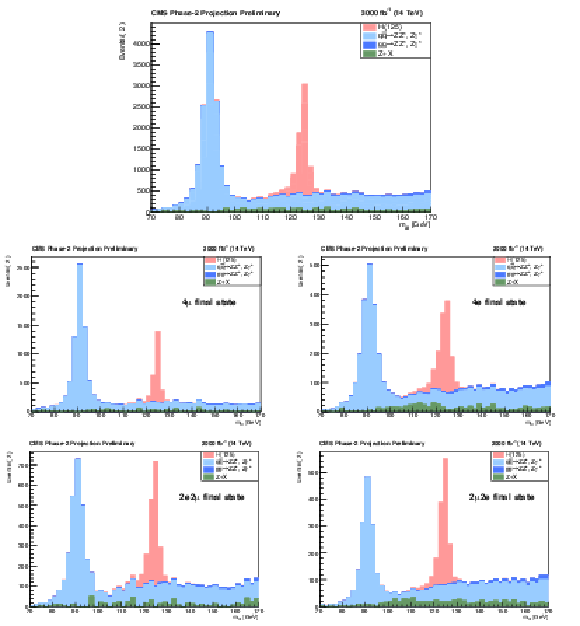
png pdf |
Figure 1:
Distribution of the four lepton invariant mass: inclusive (top), 4$\mu $ in the middle left, 4e middle right, 2e2$\mu $ bottom left and 2$\mu $2e bottom right. |
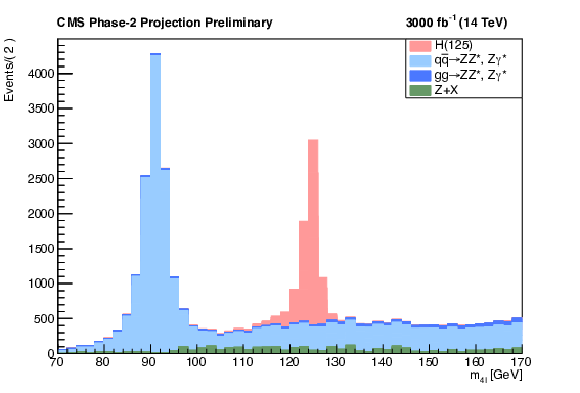
png pdf |
Figure 1-a:
Distribution of the four lepton invariant mass: inclusive (top), 4$\mu $ in the middle left, 4e middle right, 2e2$\mu $ bottom left and 2$\mu $2e bottom right. |
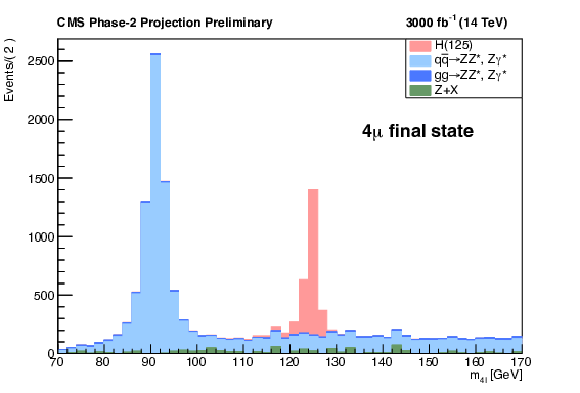
png pdf |
Figure 1-b:
Distribution of the four lepton invariant mass: inclusive (top), 4$\mu $ in the middle left, 4e middle right, 2e2$\mu $ bottom left and 2$\mu $2e bottom right. |
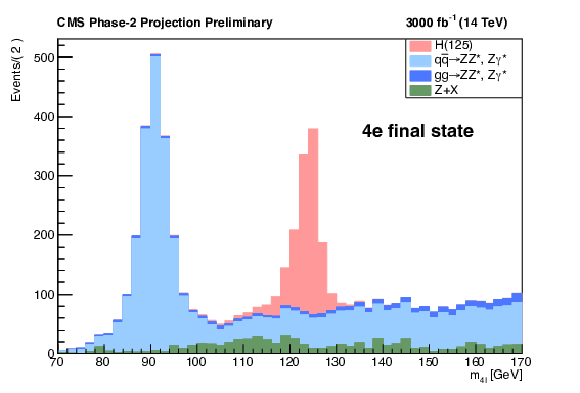
png pdf |
Figure 1-c:
Distribution of the four lepton invariant mass: inclusive (top), 4$\mu $ in the middle left, 4e middle right, 2e2$\mu $ bottom left and 2$\mu $2e bottom right. |
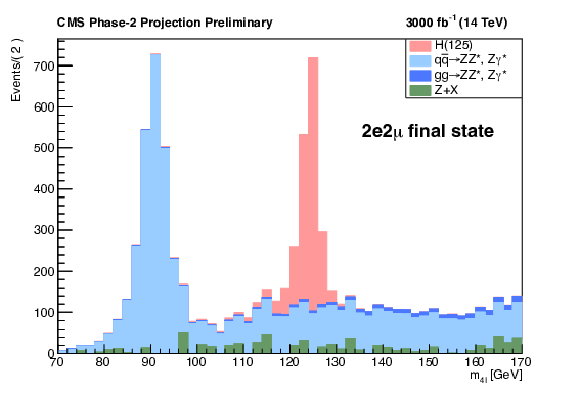
png pdf |
Figure 1-d:
Distribution of the four lepton invariant mass: inclusive (top), 4$\mu $ in the middle left, 4e middle right, 2e2$\mu $ bottom left and 2$\mu $2e bottom right. |

png pdf |
Figure 1-e:
Distribution of the four lepton invariant mass: inclusive (top), 4$\mu $ in the middle left, 4e middle right, 2e2$\mu $ bottom left and 2$\mu $2e bottom right. |
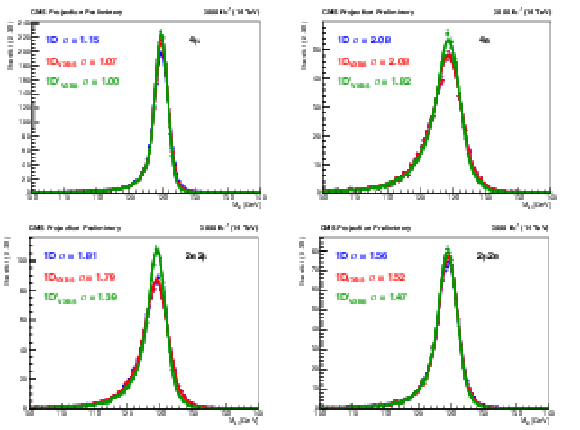
png pdf |
Figure 2:
Fits of the four lepton invariant mass distribution (4$\mu $ in the top left, 4e top right, 2e2$\mu $ bottom left and 2$\mu $2e bottom right) showing the impact of the different lepton momentum improvements: blue line no improvements, red line when VXBS is included and green line when also on-shell Z constraint is applied. The function used is a DSCB. |
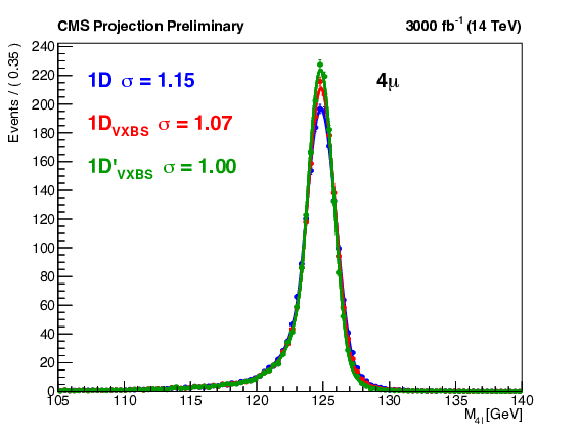
png pdf |
Figure 2-a:
Fits of the four lepton invariant mass distribution (4$\mu $ in the top left, 4e top right, 2e2$\mu $ bottom left and 2$\mu $2e bottom right) showing the impact of the different lepton momentum improvements: blue line no improvements, red line when VXBS is included and green line when also on-shell Z constraint is applied. The function used is a DSCB. |
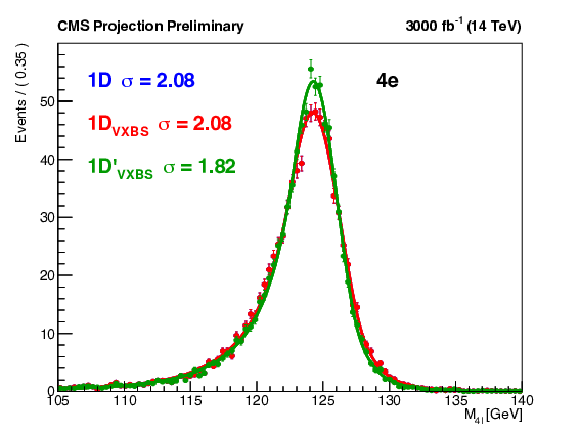
png pdf |
Figure 2-b:
Fits of the four lepton invariant mass distribution (4$\mu $ in the top left, 4e top right, 2e2$\mu $ bottom left and 2$\mu $2e bottom right) showing the impact of the different lepton momentum improvements: blue line no improvements, red line when VXBS is included and green line when also on-shell Z constraint is applied. The function used is a DSCB. |
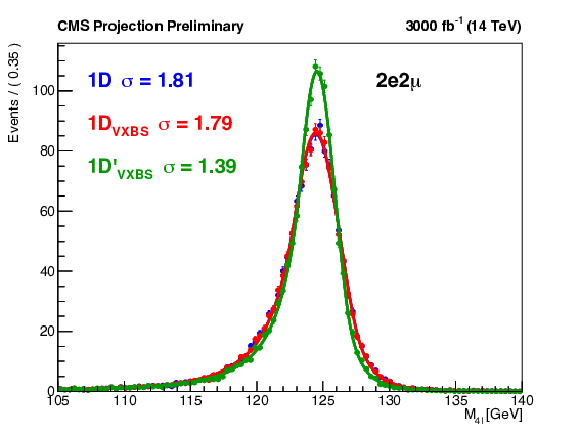
png pdf |
Figure 2-c:
Fits of the four lepton invariant mass distribution (4$\mu $ in the top left, 4e top right, 2e2$\mu $ bottom left and 2$\mu $2e bottom right) showing the impact of the different lepton momentum improvements: blue line no improvements, red line when VXBS is included and green line when also on-shell Z constraint is applied. The function used is a DSCB. |
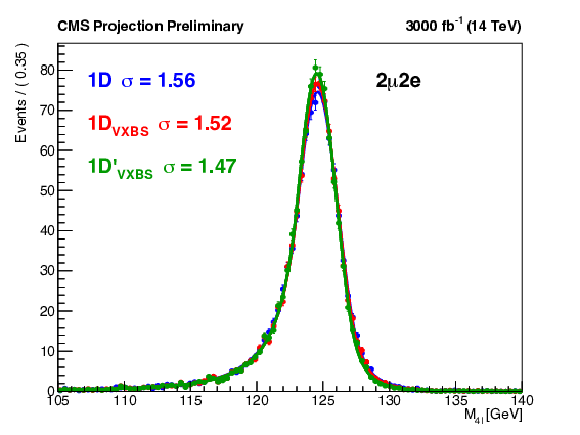
png pdf |
Figure 2-d:
Fits of the four lepton invariant mass distribution (4$\mu $ in the top left, 4e top right, 2e2$\mu $ bottom left and 2$\mu $2e bottom right) showing the impact of the different lepton momentum improvements: blue line no improvements, red line when VXBS is included and green line when also on-shell Z constraint is applied. The function used is a DSCB. |

png pdf |
Figure 3:
Fits of the 4$\mu $ invariant mass distribution, using Delphes samples (red line) and CMS Run 2 one (blue line). The production mode considered is gg $\to$ HH. |
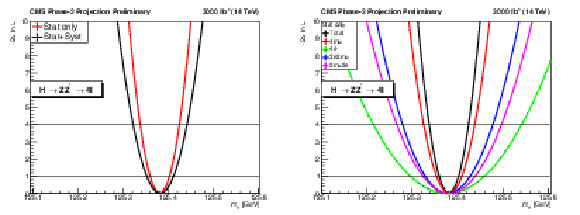
png pdf |
Figure 4:
1D likelihood scan comparing the impact of the systematic uncertainties (on the left) and the contribution of each final state (Stat only - on the right). |
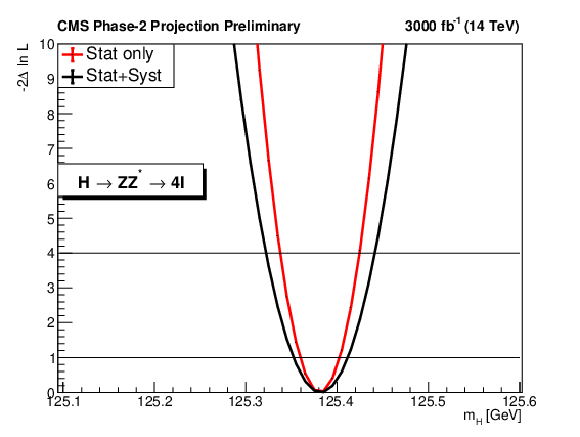
png pdf |
Figure 4-a:
1D likelihood scan comparing the impact of the systematic uncertainties (on the left) and the contribution of each final state (Stat only - on the right). |
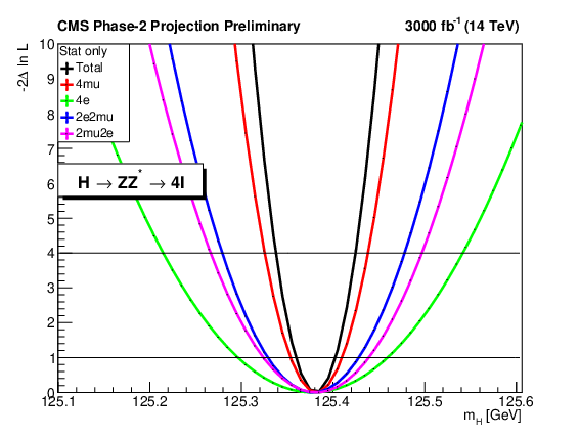
png pdf |
Figure 4-b:
1D likelihood scan comparing the impact of the systematic uncertainties (on the left) and the contribution of each final state (Stat only - on the right). |
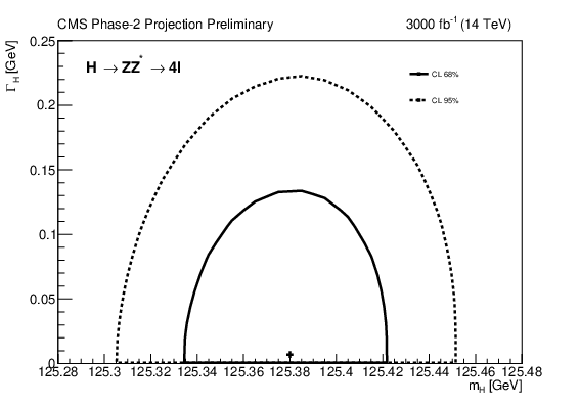
png pdf |
Figure 5:
2D likelihood scan for the Higgs boson width. |
| Tables | |

png pdf |
Table 1:
Expected yields at 3000 fb$^{-1}$ for signal and background, in the inclusive decay channel and split for final state. |

png pdf |
Table 2:
Impact of the dominant systematic uncertaintes for the different scenarios considered in the projection. As reference, YR column reports latest projection assumptions. |
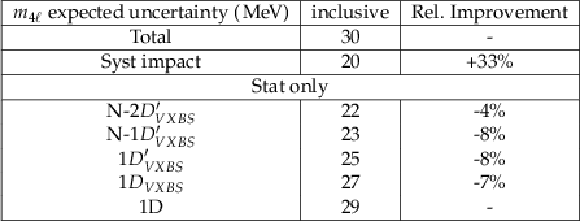
png pdf |
Table 3:
Expected Higgs boson mass measurement uncertainty, given in MeV, in the inclusive final state. |

png pdf |
Table 4:
Expected Higgs boson mass measurement uncertainty, given in MeV, for the four different final states. |

png pdf |
Table 5:
Higgs boson width upper limit at 95% C.L. |
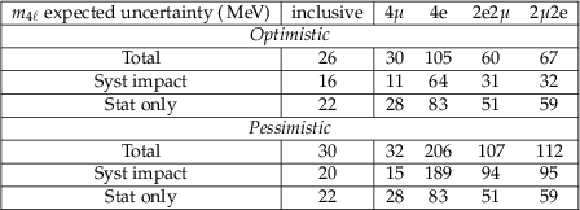
png pdf |
Table 6:
Expected Higgs boson mass measurement uncertainty, given in MeV, in the two different scenarios: Optimistic and Pessimistic. |

png pdf |
Table 7:
Expected Higgs boson width upper limit, at 95% C.L. comparing different scenarios. |
| Summary |
| Projection at the HL-LHC for the measurement of the Higgs boson mass and width, considering the on-shell production and the decay into four leptons has been presented. The scenario of 3000 fb$^{-1}$ at 14 TeV collected and analyzed by the CMS detector has been considered. The analysis workflow adopted follows the one described in Ref. [6] and [7] with several improvements, including a new approach implemented to build the final likelihood. The latest public observed results for Higgs boson mass and on-shell width measurements in the four leptons final state were extracted from the analysis of 36 fb$^{-1}$ data collected during LHC Run 2, in 2016 as follows [6]: $m_{\mathrm{H}} = $ 125.26 $\pm$ 0.20 (stat) $\pm$ 0.08 (syst) GeV and $\Gamma_{\mathrm{H}} < $ 0.41(1.10) GeV at 68(95)% confidence level. The projected expected result, at the HL-LHC, for mass measurement, is $m_{\mathrm{H}} = $ 125.38 $\pm$ 0.03 [0.022(stat) $\pm$ 0.020 (syst)] GeV and for width is $\Gamma_{\mathrm{H}} < $ 0.09 (0.18) GeV at 68(95)% confidence level. Further mass measurement improvements are foreseeable if detector upgrades are taken into account. Increased acceptance for muons and electrons and reduced systematic uncertainties (Optimistic scenario), reachable with additional statistics at the HL-LHC that will allow a better lepton calibration, lead to a mass error of 20 MeV including both statistical and systematic uncertainties. |
| References | ||||
| 1 | ATLAS Collaboration | Observation of a new particle in the search for the standard model Higgs boson with the atlas detector at the LHC | PLB 716 (2012), no. 1, 1 | 1207.7214 |
| 2 | CMS Collaboration | Observation of a new boson at a mass of 125 GeV with the CMS experiment at the LHC | PLB 716 (2012), no. 1, 30 | CMS-HIG-12-028 1207.7235 |
| 3 | CMS Collaboration | Observation of a new boson with mass near 125 GeV in pp collisions at $ \sqrt{s}= $ 7 and 8 TeV | JHEP 2013 (2013), no. 6, 81 | CMS-HIG-12-036 1303.4571 |
| 4 | CMS Collaboration | A measurement of the Higgs boson mass in the diphoton decay channel | PLB 805 (2020) 135425 | CMS-HIG-19-004 2002.06398 |
| 5 | CMS Collaboration | Evidence for off-shell Higgs boson production and first measurement of its width | CMS-PAS-HIG-21-013 | CMS-PAS-HIG-21-013 |
| 6 | CMS Collaboration | Measurements of properties of the Higgs boson decaying into the four-lepton final state in pp collisions at $ \sqrt{s}= $ 13 TeV | JHEP 2017 (2017), no. 11, 47 | CMS-HIG-16-041 1706.09936 |
| 7 | CMS Collaboration | Measurements of production cross sections of the Higgs boson in the four-lepton final state in proton-proton collisions at $ \sqrt{s} = $ 13 TeV | EPJ C 81 (2021) | CMS-HIG-19-001 2103.04956 |
| 8 | LHC Higgs Cross Section Working Group Collaboration, D. de Florian et al. | Handbook of LHC Higgs Cross Sections: 4. Deciphering the Nature of the Higgs Sector | volume 2/2017 CERN, 10 | |
| 9 | C. CMS | A MIP Timing Detector for the CMS Phase-2 Upgrade | Technical Report, CERN, Geneva, Mar | |
| 10 | D. Contardo et al. | Technical Proposal for the Phase-II Upgrade of the CMS Detector | Technical Report, Geneva, Jun, 2015 Upgrade Project Leader Deputies: Lucia Silvestris (INFN-Bari), Jeremy Mans (University of Minnesota) Additional contacts: Lucia.Silvestris@cern.ch, Jeremy.Mans@cern.ch | |
| 11 | CMS Collaboration | Expected performance of the physics objects with the upgraded CMS detector at the HL-LHC | CDS | |
| 12 | P. Nason | A new method for combining NLO QCD with shower Monte Carlo algorithms | JHEP 2004 (nov, 2004) 040 | hep-ph/0409146 |
| 13 | S. Frixione, P. Nason, and C. Oleari | Matching NLO QCD computations with parton shower simulations: the POWHEG method | JHEP 11 (2007) 070 | 0709.2092 |
| 14 | S. Alioli, P. Nason, C. Oleari, and E. Re | A general framework for implementing NLO calculations in shower Monte Carlo programs: the POWHEG BOX | JHEP 06 (2010) 043 | 1002.2581 |
| 15 | A. V. Gritsan et al. | New features in the jhu generator framework: Constraining Higgs boson properties from on-shell and off-shell production | PRD 102 (Sep, 2020) 056022 | 2002.09888 |
| 16 | A. V. Gritsan, R. Rontsch, M. Schulze, and M. Xiao | Constraining anomalous Higgs boson couplings to the heavy-flavor fermions using matrix element techniques | PRD 94 (Sep, 2016) 055023 | 1606.03107 |
| 17 | J. M. Campbell and R. K. Ellis | MCFM for the Tevatron and the LHC | NPPS 205 (2010) 10 | 1007.3492 |
| 18 | R. D. Ball et al. | Parton distributions for the LHC run ii | JHEP 2015 (2015), no. 4, 40 | 1410.8849 |
| 19 | T. Sjostrand et al. | An introduction to PYTHIA 8.2 | CPC 191 (2015) 159 | 1410.3012 |
| 20 | CMS Collaboration | Extraction and validation of a new set of cms pythia8 tunes from underlying-event measurements | EPJC 80 (2020), no. 1, 4 | CMS-GEN-17-001 1903.12179 |
| 21 | GEANT4 Collaboration | GEANT4: a simulation toolkit | NIMA 506 (2003) 250 | |
| 22 | J. Allison et al. | Geant4 developments and applications | IEEE Trans. Nucl. Sci. 53 (2006) 270 | |
| 23 | J. de Favereau et al. | Delphes 3: a modular framework for fast simulation of a generic collider experiment | JHEP 2014 (2014), no. 2, 57 | 1307.6346 |
| 24 | CMS Collaboration | Electron and photon reconstruction and identification with the CMS experiment at the CERN LHC | JINST 16 (may, 2021) P05014 | CMS-EGM-17-001 2012.06888 |
| 25 | CMS Collaboration | Performance of the CMS muon detector and muon reconstruction with proton-proton collisions at $ \sqrt{s}= $ 13 TeV | JINST 13 (jun, 2018) P06015 | CMS-MUO-16-001 1804.04528 |
| 26 | Y. Gao et al. | Publisher's note: Spin determination of single-produced resonances at hadron colliders [phys. rev. d 81, 075022 (2010)] | PRD 81 (Apr, 2010) 079905 | 1001.3396 |
| 27 | S. Bolognesi et al. | Spin and parity of a single-produced resonance at the LHC | PRD 86 (Nov, 2012) 095031 | 1208.4018 |
| 28 | I. Anderson et al. | Constraining anomalous $ hvv $ interactions at proton and lepton colliders | PRD 89 (Feb, 2014) 035007 | 1309.4819 |
| 29 | M. Grazzini, S. Kallweit, and D. Rathlev | Zz production at the LHC: Fiducial cross sections and distributions in nnlo qcd | PLB 750 (2015) 407 | 1507.06257 |
| 30 | M. Bonvini et al. | Signal-background interference effects in $ gg \to H \to WW $ beyond leading order | PRD 88 (2013) 034032 | 1304.3053 |
| 31 | K. Melnikov and M. Dowling | Production of two z-bosons in gluon fusion in the heavy top quark approximation | PLB 744 (2015) 43 | 1503.01274 |
| 32 | D. Y. S. Chong Sheng Li, Hai Tao Li and J. Wang | Soft gluon resummation in the signal-background interference process of $ gg\rightarrow (h^*)\rightarrow ZZ $ | JHEP 08 (2015) 065 | 1504.02388 |
| 33 | G. Passarino | Higgs cat | EPJC 74 (2014) | |
| 34 | S. Catani and M. Grazzini | Next-to-next-to-leading-order subtraction formalism in hadron collisions and its application to Higgs-boson production at the large hadron collider | PRL 98 (May, 2007) 222002 | |
| 35 | M. Grazzini | Nnlo predictions for the Higgs boson signal in the $ h \rightarrow ww \rightarrow \ell \nu \ell \nu $ and $ h \rightarrow zz \rightarrow 4\ell $ decay channels | JHEP 02 (2008) | |
| 36 | CMS Collaboration | Measurements of properties of the Higgs boson decaying into the four-lepton final state in pp collisions at $ | JHEP 11 (2017) 47 | |
| 37 | CMS Collaboration | The Phase-2 Upgrade of the CMS Tracker | CMS-PAS-TDR-17-001 | CMS-PAS-TDR-17-001 |
| 38 | CMS Collaboration | The Phase-2 Upgrade of the CMS Muon Detectors | CMS-PAS-TDR-17-003 | CMS-PAS-TDR-17-003 |

|
Compact Muon Solenoid LHC, CERN |

|

|

|

|

|

|